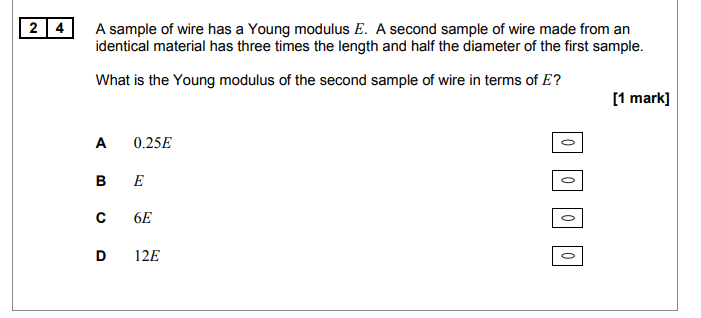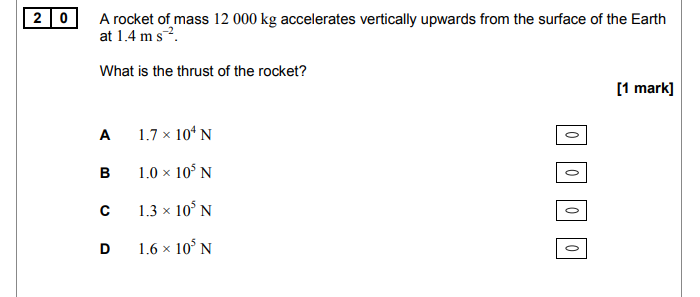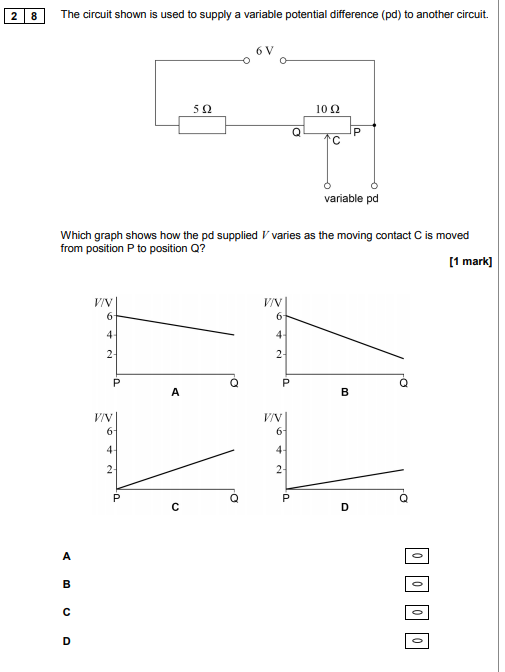Multiple Choice Questions help
Hey guys, I've got some multiple choice questions I'd like some help with please!

With this one I'm confused. I thought surely because the diameter is halved, and this the area is quartered, the youngs modulus of the second sample would be 12E? The three times the length increases the YM by 3, the area is in the denominator so that would increase it by 4, so 12 times the youngs modulus, no??

This one I've just forgotten how to do, I know it's about resolving but I just can't remember, any help would be appreciated.

Honestly kinda a similar thing here too, not sure why it's A, surely others like C make sense too?
Thanks a lot.

With this one I'm confused. I thought surely because the diameter is halved, and this the area is quartered, the youngs modulus of the second sample would be 12E? The three times the length increases the YM by 3, the area is in the denominator so that would increase it by 4, so 12 times the youngs modulus, no??

This one I've just forgotten how to do, I know it's about resolving but I just can't remember, any help would be appreciated.

Honestly kinda a similar thing here too, not sure why it's A, surely others like C make sense too?
Thanks a lot.
For 24, EDITED - YM is constant for a given material!!!
For q20, you can use F=ma to find the resultant force.
There are two forces acting on the rocket, its weight and the thrust and these must give a resultant equal to the F=ma you calculated.
For Q18, equilibrium means forces AND moments are balanced. Choose a point in C to take moments around (for example choose the centre) and you'll find there IS a non-zero moment.
For q20, you can use F=ma to find the resultant force.
There are two forces acting on the rocket, its weight and the thrust and these must give a resultant equal to the F=ma you calculated.
For Q18, equilibrium means forces AND moments are balanced. Choose a point in C to take moments around (for example choose the centre) and you'll find there IS a non-zero moment.
(edited 6 years ago)
Original post by phys981
For q1, remember that YM depends on cross-sectional area which goes as the square of the diameter. If the diameter changes by factor 0.5, then the area goes by 0.5² or 0.25
So YM = FL/AdeltaL
If the area is reduced to 1/4 of it's original value, the YM is 4 times greater right? Or am I being confused?
Original post by phys981
Yes! Sorry, and so am I (confised).
YM is a constant for a given material. If we change the lenght and area the extension might also change for a given force but YM remains the same.
(should have read properly before answering...)
YM is a constant for a given material. If we change the lenght and area the extension might also change for a given force but YM remains the same.
(should have read properly before answering...)
So it's kinda a trick question, and the answer is based off of it being the same material and so regardless of other factors, YM is the same?
Original post by phys981
Yes.

Any idea on this one? I got it right, it's C, but I just did it by considering the ratios, 2:1 split of the PD and the only one which goes to 4V is the third graph, kinda a BS way of doing it and I don't understand what I've done really
You're right, really.
Based on the ratio of resistances, the p.d. across that 10 Ohm resistormust be 4V. So, with the sliding contacts one at either end, they will cover the whole of that 4V. However, as you slide the moveable one towards the right, it covers less and less of the 10Ohm resistor so gets less and less of the 4V until it reaches P and 0V.
Based on the ratio of resistances, the p.d. across that 10 Ohm resistormust be 4V. So, with the sliding contacts one at either end, they will cover the whole of that 4V. However, as you slide the moveable one towards the right, it covers less and less of the 10Ohm resistor so gets less and less of the 4V until it reaches P and 0V.
Original post by phys981
You're right, really.
Based on the ratio of resistances, the p.d. across that 10 Ohm resistormust be 4V. So, with the sliding contacts one at either end, they will cover the whole of that 4V. However, as you slide the moveable one towards the right, it covers less and less of the 10Ohm resistor so gets less and less of the 4V until it reaches P and 0V.
Based on the ratio of resistances, the p.d. across that 10 Ohm resistormust be 4V. So, with the sliding contacts one at either end, they will cover the whole of that 4V. However, as you slide the moveable one towards the right, it covers less and less of the 10Ohm resistor so gets less and less of the 4V until it reaches P and 0V.
Yeah that does make sense, cheers bro! Electricity really isn't one of my strong points, anything you'd recommend doing to get a lot stronger at it? I've always had issues with it really.
Quick Reply
Related discussions
- Uni of Sheffield Exams
- Uni revision stratgergies
- Anybody finished the 'Access to bath' end assessment course? what's it like?
- The topic of Particles in A-Level physics
- AQA A Level Law Paper 3 (7162/3) - 10th June 2024 [Exam Chat]
- Senior Physics Challenge Isaac Physics
- AQA A Level Biology Paper 2 Unofficial Markscheme
- i need help on bio, chem and physics
- Harris Westminster sixth form
- Brighton College Entrance exam for 16+
- How to prepare and ace theory test??!!!
- arbitio vs law mind (lnat+ps)
- How to revise for BPHO intermediate challenge
- Brighton College
- KCL Nursing 2024
- Retaking maths GCSE need desperate help!
- Cambridge Philosophy Admissions test
- Exam Tips: Effective double checking of answers
- MAT practice
- How do you start preparing for the Oxford PPE admissions test?
Latest
Last reply 2 minutes ago
Goldmansachs Degree Apprenticeship 2024Last reply 3 minutes ago
Official University of St Andrews Applicant Thread for 2024Last reply 3 minutes ago
JK Rowling in ‘arrest me’ challenge over hate crime lawLast reply 5 minutes ago
Official Cambridge Postgraduate Applicants 2024 ThreadLast reply 7 minutes ago
Official University of Edinburgh Offer Holders Thread for 2024 entryPosted 7 minutes ago
Unit 11 cyber security and incident management btechLast reply 8 minutes ago
Got Red Light Penalty Notice - First Time Offender - Course EligibilityPosted 10 minutes ago
Level 6 apprenticeship after level 4 courseLast reply 10 minutes ago
Official University of Edinburgh Applicant Thread for 2024Last reply 10 minutes ago
can someone mark my english language question 5 please (40)Last reply 11 minutes ago
Official University College London Applicant Thread for 2024Last reply 13 minutes ago
Dwp pre employment checksLast reply 17 minutes ago
Official UCL Offer Holders Thread for 2024 entryLast reply 21 minutes ago
Nottingham university or MMU for Msc Psychology conversion (online)Last reply 21 minutes ago
UCL (University College London) Postgraduate Applicants 2024-25Last reply 21 minutes ago
LSE Economics L100 2024 Entry



